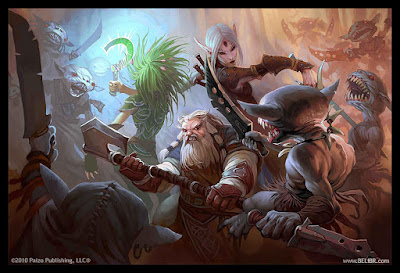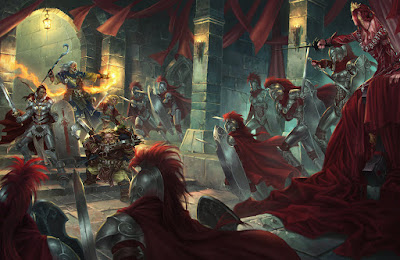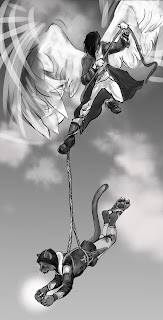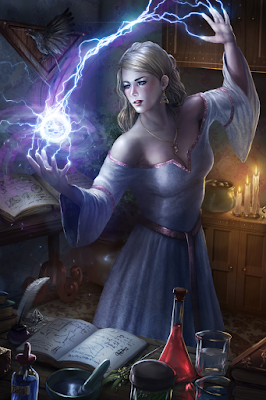 |
| There's no crying in battle! |
Tier one encompasses level 1 to level 4 characters. Characters are apprentices. Everybody gets one attack on their turn. Spells are basic damage-dealing effects or things that only affect one character at a time. According to the Player's Handbook, they deal with threats that endanger farmsteads or villages. The genre is generally considered "Sword and Sorcery" and a lot of OSR games specifically go for this tier due to the constant threat of death. In Alanna: The First Adventure, the heroine spends a majority of the book training and facing small challenges. At the end of the book, she defeats an enemy that threatened a city, with the help of a powerful magic item.
Tier two encompasses level 5 to 10. At this point, the characters are competent adventurers. Nearly all of the martial classes gain a second attack, magic users gain access to much more potent spells, and the party can deal with dangers that threaten cities or even regions. This is the most flexible tier in terms of genre, but a traditional D&D game will fall into "Heroic Fantasy." When most people think of D&D, this is the level of play they think of. In In the Hand of the Goddess, the heroine is recognized as a skilled fighter among all the knights in the kingdom, and disposes of an evil sorcerer with plans to take over the throne.
Tier three covers levels 11 to 16. The characters are now head and shoulders above the common rabble. Spells create devastating effects, or effects that can cover large groups of enemies. Fighters become capable of dishing out massive damage while taking a huge beating themselves. At this point, the presence of high-level magic means that this genre will nearly always be "High Fantasy". The characters are at Lord of the Rings levels - able to take on armies and legendary evils. In The Woman Who Rides Like a Man, the heroine deals with multiple crazed wizards, cursed swords, travels long distances overland, and fights in wars that determine the fate of countries.
Finally, we get to Tier four, levels 17-20. The heroes are now legends. They can take on horrifyingly deadly challenges and can use their might or magic to change the whole world. At this level, "Epic Fantasy" only barely suffices - the characters could hold the entire multiverse in the balance. In Lioness Rampant, the heroine fights alongside a legendary martial arts master and a warrior king, defeats an immortal mountain God, and finishes off an undead wizard (basically Lich-level) with plans to rule the world via horrible disease.
 |
| The art goes perfectly with the tiers as well |
At tier one, each PC gets one attack. That means if you put a villain in front of the group, they have to be able to take 4-6 hits a round. That's a lot. And the math only gets worse at higher tiers.
Also, what happens when your Bard gets Hypnotic Pattern at tier two? Suddenly your boss monster is incapacitated. There goes a round of damage on your PCs. What about Fireball? Goodbye, room full of minions.
Essentially, each tier doesn't just necessitate a new genre of play. It means a whole new set of encounter design rules, and different styles of combat. If you run a tier three combat the same way you'd run a tier one combat, you're in for a long, painful session.
At each tier, I'm going to go over how you should use:
- Initiative/turn order
- Strategy
- Terrain
- Combat Descriptions
- Enemy Identification
- PC Allies
- Ending the Combat
Before we get into this, I do want to point out that this system of running combat is built into how I play D&D: a focus on story, with generally one or two big combats a session. My players nearly always have the chance to take a short/long rest between combats, and as a result the combat encounters are nearly always "deadly" by DMG standards (pg. 82)
Tier One Combat: Threats Everywhere
 |
| Every blow matters! |
If you want to run a boss fight at this tier, the best option is to use a mid-level monster with a weak monster as their ally. Despite magic being weak at this tier, spells like Hold Person and Blindness/Deafness can muck up the encounter if the PCs are only facing one enemy.
Alternatively, you can make a single monster who is a paragon (essentially, two or more monsters built into a single enemy). This can be particularly effective if you want to make a Goblin Boss that doesn't suck (unlike MM pg. 166) or a more powerful Kobold. Just stack them on top of each other!
As for running this tier in a combat, you can use a "traditional" combat approach.
- Roll initiative for each monster.
- For strategy, use the most unique monster ability first. These are the "signature" abilities that make a monster stand out. Nobody is going to use a mimic as just another ooze! Put the PCs in a position to show off the monster's abilities!
- Terrain should be varied, so the players have things to move around and interact with. Teach them the rules of cover, improvised weapons, chokepoints, height advantage, etc.
- On each turn of combat (monster and PC alike), describe the attacker's position, how they attack, and how their target defends (or how much they injure their target). This is really important: it's how you give a low-level combat "impact"!
- Every monster needs a personality. Even if it's "the wolf with white stripes on its head" or "the bandit with a scar over his left eye", the players should be connecting with every villain they face. There are no faceless goons in this tier.
- If the PCs happen to have gained any allies (unlikely, but possible), they should be given their own spot in the initiative. Treat them as another PC - give them full descriptions and personality - but don't let the PCs run them quite yet.
- Fight to the very last hit point. If you want to end the combat with a chase scene, you can have the monster flee, but most players won't take kindly to that.
At this tier, combat should be visceral and dangerous. A lot of people fall in love with this feeling and try to make their entire campaign world feel like this. If you're into that, an OSR system like Lamentations of the Flame Princess or Dungeon Crawl Classic would provide the right experience.
Tier Two Combat: Bigger Fish to Fry
 |
| Commonly heard at this tier: "holy crap, we don't suck!" |
The players can now face a full horde of weak monsters, even taking them all out in one shot if the wizard gets a lucky Fireball off. At this point, every major mass combat needs to have potential reinforcements. If the characters blast away your group of hobgoblin soldiers, that might be okay. But if this is supposed to be the elite guard of Hobgoblin City, you'll want them to have backup.
A side effect of this is that the players won't feel endangered by the wilderness anymore. So, instead of running every little encounter the PCs would come across, give them the highlights: "you cross through the forest of evil, fending off attacks from packs of wolves and bands of orcs". Then, if they find a suitably dangerous encounter, run it normally: "on the third day, you come across the tracks of a Hill Giant, still fresh".
Your best best is to run the group against a party of mid-level monsters, the ones that would have been bosses in tier one. They can soak up some damage, make saves against debilitating effects, and still dish out a beating. Since each of these monsters is powerful enough to be the boss of a group of weaker monsters (as they were in tier one), you can still make the combat feel like it matters. Just have the angry pitchfork mob take care of the Goblins while your PCs go after their troll bosses.
Finally, if you want to run a boss fight, you'll need to throw in a group of weaker allies to make it feel suitably epic. Don't go too weak - otherwise they'll go down in the first round. But a higher-level monster with some mid-level allies is fairly epic. Again, Paragon monsters are a good way to make a single enemy more durable and menacing.
At this tier, you can use similar combat techniques, with a few truncations:
- Roll initiative for monster bosses, then divide the rest of the monsters up by type (all goblins, all skeletons, all goblin skeletons), or just divide the minions into their own groups.
- Monsters start getting smarter at this stage. Think about what the monster would do, based on their ability scores (especially their mental ability scores!). This site is a good reference.
- Terrain can shift over the course of the battle, and should be able to damage the characters. Lay traps. Fight near lava or spiked pits. Surprise the players.
- For the PCs, describe their attacks and positioning, as well as narrating the effect their attacks have on the monsters. Do the same for monster bosses, but skimp on the minions - a simple tally of damage will suffice.
- Give monster bosses personality, but for the rest you can use "group mentality" as your description: the goblins are murderous, the zombies are lurching relentlessly forward.
- Treat PC allies the same as in tier one - give them their own initiative and descriptions. However, you might consider letting the PCs control them at this point. Many martial classes at this level can become bored when they are just making attacks (while the wizard picks a new spell each round), so giving them an additional responsibility in combat can ease that boredom.
- When the enemy has been reduced to one or two minions, end the combat. You can roll to see if the monster escapes or is killed, but unless you want to start a chase scene, assume they die. If they are captured, they'll need a personality and name, so don't be surprised when your players ask!
This is, honestly, the style of combat that D&D is best at. You can really get a feel for the life-and-death nature of the combat while fighting for causes that matter at a local level. Whereas tier one was focused on survival and victory, this tier can encompass larger concepts within the framework of a combat. Make things morally grey, since your players will actually have the time to think about it rather than focusing on pure self-defense.
Tier Three Combat: Saving the World
 |
| 100 vs 4? No chance - bet on the 4. |
The party can take on large groups of mid-level monsters and even multiple higher-level monsters. That isn't a statement to be taken lightly: if every goblin horde is run by a troll, and the heroes can take on the entire troll community, they can scatter an entire army. These are heroes that leave the rank-and-file soldiers to their allies and go right for the generals.
Additionally, spells at this tier make the world easily traversable for the party. Wilderness travel? No worries, the Wizard knows Teleportation. Even if they do hoof it, they will be taking down pretty much everything they come across.
That does mean, however, that they'll attract the attention of the truly dangerous wilderness monsters. Giants and Dragons are going to come to visit them and consider them a real threat.
Also at this tier, mass combat becomes a real possibility. A well-equipped PC can face down a squadron of guards or low-level undead. If you don't have a solid rules system to deal with huge groups of enemies, I'd suggest this brilliant essay on building mass combat units, or use the AoE and Mob combat rules in the DMG (pg. 249-250).
Finally, to run a boss battle at this level, you need to make it a staged battle. That is, the battle has to occur in stages. Run the boss's minions first, then their minibosses, then the boss themselves. No resting in between.
Why do we need to do this?
Well, D&D, at its core, is a game of resource management. If you use your 6th level spell slot on Mass Suggestion, that means you don't get to use it for Otto's Irresistable Dance. In a normal D&D game, the players would be running through 2-3 combats between rests, or 5-6 combats between long rests. That's plenty of opportunities to whittle down the PC's resources before the final, epic fight.
However, in a session with only one major combat, we need to simulate that resource use within one fight. That's why paragon monsters are so useful: since they essentially reset between HP pools, they simulate fighting multiple combats. If Hold Person wears off twice during the battle, it's the same as if it were cast twice earlier that day.
Thus, final boss fights at this tier need to be done in stages, and paragons/multi-stage bosses are basically a requirement.
At this tier, combat becomes a whole new situation. If you want to run a combat that has any modicum of urgency, you'll need to change the way you run quite a bit.
- Divide monsters into units. Bosses are their own unit. Roll initiative for each unit (similar to the last tier).
- Monsters at this level are nearly always smart. They aren't beasts or thugs. Prepare a strategy for the monsters and figure out a backup plan if things go awry.
- Terrain should shift drastically over the course of the battle. Force players to move! Make pillars fall and the ground crack open! There's a reason monsters at this tier start gaining lair actions. Use them!
- Reduce your descriptions to basic position and attack information ("You rush forward and unleash a flurry of slashes with your longsword") rather than spelling out each attack. Do this for both monsters and PCs. Then, pick a few attacks per combat to fully describe (big spells, killing blows, etc)
- Enemies should have the same level of personality as the previous tier: bosses get personas, minions don't. Minibosses can have simple personalities (Boris the Smasher and Doris the Basher).
- At this point, allies fall into two categories: mass units and named allies.
- For mass units, you can either assign an enemy unit to fight them and take them out of the order, or you can treat them as a single entity as described in the mass combat essay above.
- For named allies, you can give them their own position in the initiative if they are powerful enough, or you can simply have a PC gain some temporary hit points or extra damage as a result of fighting alongside their ally.
- Combat ends when the boss is killed, or when 90% of the minions are dead. Assume that the PCs then finish off the rest of the enemies, since they likely won't need to spend any major resources doing so. You'll nearly always have to deal with captured enemies at this stage.
This level of combat is more difficult to pull off in vanilla D&D. That's why we start pulling in alternate rule sets and expanded strategies. However, it can be done - but if done poorly, you'll end up with a 3 to 4 hour combat on your hands. Speaking from personal experience: ain't nobody got time for that.
Tier Four Combat: The Fate of Existence
 |
| Time to fight God's Armies? Must be Tuesday... |
At this level, the party could fight 350 city watchmen without breaking a sweat. They can take out the biggest, baddest monsters of all time, all the way up to the CR 30 Tarrasque.
This means that major villains are going to team up against them. A Lich is easy prey - the undead wizard is going to bring along their pet Dracolich and a squad of Iron Golems for good measure. However, a better approach would simply be to not fight the PCs. At this level, nearly everything would rather save its own hide - even an Ancient Dragon will negotiate rather than face the choice of death or flee.
Of course, you need some high-level combat, not just high-level negotiations. That's why so many of the high-level monsters are irredeemably evil (liches, fiends, dragons, krakens, etc). They will fight the PCs without hesitation. But it isn't quite that simple.
At this point, every monster is smart and informed. The PCs are legendary, there's nobody who they want to fight who isn't going to hear about them coming. The enemy will have a strategy that is specific to the PCs in the party. If a PC can cast 9th level spells, the enemy will prepare 9th-level Counterspells. If a PC has great stealth or perception, the enemy will try to avoid being surprised or not bother trying to cause surprise. They will pull out all the stops.
There comes a problem at this tier: things just aren't strong enough to take on the PCs. Remember, the game is designed to be a battle of attrition. The PCs are supposed to use up their resources before the final battle. At 17th level, the PCs are expected to have already fought 4-5 battles worth 15,600 experience each before they hit the boss fight. Yes, that really does mean they need to fight 4 or 5 Iron Golems before they face off against the Evil Wizard.
And here's the kicker: the Evil Wizard knows that. That's why he built those Iron Golems. So he could fight the PCs when they weren't at their best! So he could stand a chance of winning against four legendary heroes. That's the mentality you have to go into for these battles.
So if you're making a "final showdown", you have a few options:
- Do it as above: actually play the game of attrition and have a series of minibosses before the final boss.
- Use traps, counters, or terrain effects to hamstring the PCs for the final fight, since the boss would know their weaknesses. Make sure you give the PCs a way to break free of the traps.
- Make the boss a paragon monster. Have each "stage" of the boss become progressively more difficult to simulate multiple battles.
- Use a beefed up version of the monster with plenty of Legendary Actions and tons of extra HP to absorb the PC's effects. Also, limited magic immunity. I'm not joking. It's not fun when God goes down to Tasha's Hideous Laughter.
Which one is best for a particular situation? Well, it depends. An Evil Overlord will probably use minions to wear the party down, a Mad Wizard will almost certainly use traps to hamstring the party. A God is likely to just use a massive stat block, paragon or beefy.
At this level, the PCs will breeze through "normal boss" monsters and their armies. It's almost not worth it to run anything less than a full-on epic boss battle. However, you can have them roll some skill checks or attack rolls if you want them to take out an army at some point.
 |
| From "I cast Magic Missile!" to "I alter the fabric of reality for fun!" |
- In mass combat, have the monsters all go at once. Enact their strategies as a kind of push/pull flow of combat: the players go, the enemies respond. If there are few enough enemies to actually have names, give them their own initiative spot. Also, reserve initiative count 20 and/or 10 for terrain effects, lair effects, or traps.
- Prepare a strategy your monsters follow. Nearly everything at this level is smart, so know ahead of time what will happen on each round of combat and how the monster reacts to certain things. Tailor your strategy to your PCs! Think about how this monster would squelch their go-to actions. Don't let them use their archetype.
- The battle should shift between multiple types of terrain - keep things moving in new directions. Perhaps the villain takes to the sea or sky, perhaps you are teleported to a new locale, perhaps traps start springing or the villain flees through areas already explored. It helps to have minions/paragon stages, as this gives you an easy indicator of when the battle needs to shift.
- Final Bosses and named second-in-commands get personality. Everyone else is just a faceless minion. However, you can give certain squads a "group personality", like having the "executioner squad" or an "arrow unit" among the minions. Just remember: they don't get anything more than that!
- Allies might be named or full army units.
- If they have full armies, you can handwave combat between them and the foe's minions, counting up casualties after the battle. Or, you can build Mass Combat Units and grant them initiative.
- For named units, you can create minibosses for them to fight in the same manner. Or you can treat them as a Mass Combat Unit as well. Perhaps Jerrard the Knight now has an order of knights under his command.
- For either one, you can grant the ally to a player and give them a big bonus. If a PC has a following of assassins, they could gain a big bonus to damage on their hits, or if a PC is joined by their lifelong knight ally, he could grant an AC or HP bonus.
- Similar to the last tier, combat ends when the boss is killed, or when 90% of the minions are dead. Assume that the PCs then finish off the rest of the enemies, since they likely won't need to spend any major resources doing so. You'll nearly always have to deal with captured enemies at this stage.
This is a very difficult tier to pull off in combat, and there are some systems that do it better than D&D. However, the strength of D&D 5e is that it's a robust system that can put up with a lot of homebrew changes. So I think 5e is fine for doing this, workable but not the best.
In summary, running combat in D&D isn't as straightforward as the books suggest. If you want to run impactful, efficient combats at every level of play, you'll need to adjust your strategies.
Thanks for reading!























